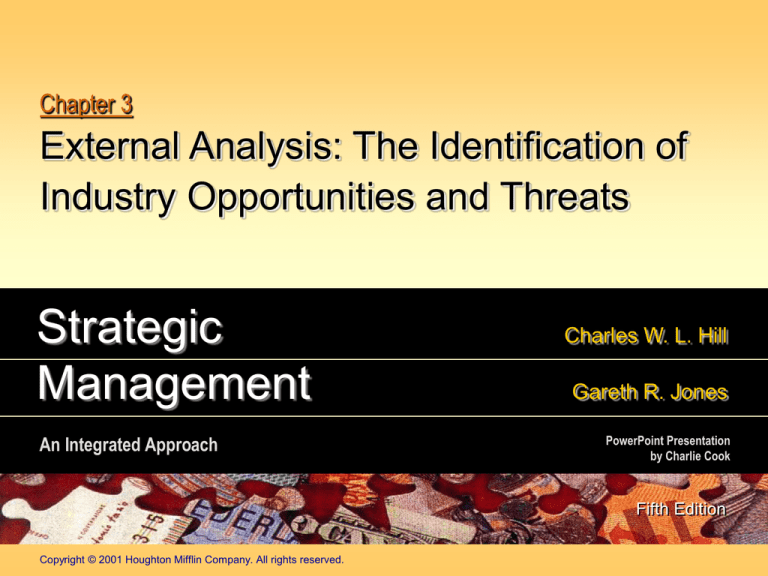
Chapter 3
External Analysis: The Identification of
Industry Opportunities and Threats
Strategic
Management
An Integrated Approach
Charles W. L. Hill
Gareth R. Jones
PowerPoint Presentation
by Charlie Cook
Fifth Edition
Copyright © 2001 Houghton Mifflin Company. All rights reserved.
Analyzing Industry Structure
Opportunities and threats are competitive
challenges arising for changes in industry
conditions.
Analytic tools such as the
five forces model help
managers formulate
appropriate strategic
responses.
Copyright © 2001 Houghton Mifflin Company. All rights reserved.
3-2
The Five Forces Model
FIGURE 3.1
Copyright © 2001 Houghton Mifflin Company. All rights reserved.
Source: Adapted and reprinted by permission of Harvard Business
Review. An exhibit from “How Competitive Forces Shape Strategy”
by Michael E.. Porter (March-April 1979), Copyright © 1979 by the
3-3
President and Fellows of Harvard College: all rights reserved.
Potential Competitors
New entrants into an industry threaten incumbent
companies.
Barriers to entry:
Brand loyalty
Absolute cost advantages
Economies of scale
Switching costs
Government regulation
Entry barriers reduce the threat
of new and additional competition.
Copyright © 2001 Houghton Mifflin Company. All rights reserved.
3-4
Rivalry Among Established Companies
The intensity of competitive rivalry in an
industry arises from:
Industry’s competitive structure.
Demand (growth or decline) conditions in industry.
Height of industry exit barriers.
Copyright © 2001 Houghton Mifflin Company. All rights reserved.
3-5
Competitive Structure
Continuum of
Industry Structures
Fragmented
Many firms,
no dominant
firm
Few firms,
shared dominance
(oligopoly)
Copyright © 2001 Houghton Mifflin Company. All rights reserved.
Consolidated
One firm or one
dominant firm
(monopoly)
3-6
The Bargaining Power of Buyers
Buyers are most powerful when:
There are many small sellers and few large buyers.
Buyers purchase in large quantities.
A single buyer is a large customer to a firm.
Buyers can switch suppliers at low cost.
Buyers purchase from multiple sellers at once.
Buyers can easily vertically integrate to compete with
suppliers.
Copyright © 2001 Houghton Mifflin Company. All rights reserved.
3-7
The Bargaining Power of Suppliers
Suppliers have bargaining power when:
Their products have few substitutes and are important
to buyers.
The buyer’s industry is not an important customer to
the supplier.
Differentiation makes it costly for buyers to switch
suppliers.
Suppliers can vertically integrate forward to compete
with buyers and buyers can’t integrate backward to
supply their own needs.
Copyright © 2001 Houghton Mifflin Company. All rights reserved.
3-8
Substitute Products
The competitive threat of substitute products
increases as they come closer to serving
similar customer needs.
Far
Copyright © 2001 Houghton Mifflin Company. All rights reserved.
Close
3-9
A Sixth Force: Complementors
Complementors:
Companies whose products are sold in tandem with
another company’s products.
Increased supply of a complementary product
collaterally increases demand for the primary product.
Example:
Faster CPU chips fuel sales
of personal computers.
Copyright © 2001 Houghton Mifflin Company. All rights reserved.
3-10
The Role of the Macroenvironment
FIGURE 3.2
Copyright © 2001 Houghton Mifflin Company. All rights reserved.
3-11
Strategic Groups Within Industries
The concept of strategic groups
Within an industry, a competitor grouping using
similar strategies that differ from other industry
groups.
Implications of strategic groups
The closest industry competitors are those in the
group.
The various industry groups are differentially and
competitively advantaged and positioned.
Mobility barriers inhibit the movement of competitors
from one strategic group to another.
Copyright © 2001 Houghton Mifflin Company. All rights reserved.
3-12
Strategic Groups in the Pharmaceutical
Industry
FIGURE 3.3
Copyright © 2001 Houghton Mifflin Company. All rights reserved.
3-13
Limitations of the Five Forces and Strategic
Group Models
Both models are static and ignore innovation.
Their focus is on industry and group
structures rather than individual companies.
Innovation creates change in
industry structures, altering the
competitive environment.
Industry structure cannot
fully explain the performance
differences between industry
competitors.
Copyright © 2001 Houghton Mifflin Company. All rights reserved.
3-14
Punctuated
Equilibrium
and
Competitive
Structure
FIGURE 3.4
Copyright © 2001 Houghton Mifflin Company. All rights reserved.
3-15
The Industry Life Cycle Model
Stages in the industry life cycle:
FIGURE 3.5
Copyright © 2001 Houghton Mifflin Company. All rights reserved.
3-16
Growth in Demand and Capacity
FIGURE 3.6
Copyright © 2001 Houghton Mifflin Company. All rights reserved.
3-17
Network Economics As a Determinant of
Industry Conditions
The demand for primary industry products
depends on the size of the total market for
complementary products.
Network economics result in
positive feedback loops that
foster rapid demand increases.
Market competitors are
protected by switching
cost entry barriers.
Copyright © 2001 Houghton Mifflin Company. All rights reserved.
3-18
Positive Feedback in the Computer
Industry
FIGURE 3.7
Copyright © 2001 Houghton Mifflin Company. All rights reserved.
3-19
Globalization and Industry Structure
Globalization
Globally dispersed production lowers
costs and increases quality.
Global markets are replacing
national markets.
Trend implications
No isolated national markets
More competitors, more intense competition
More rapid innovation and shorter product life cycles
Copyright © 2001 Houghton Mifflin Company. All rights reserved.
3-20
The Nation-State and Competitive
Advantage
The determinants of competitive advantage:
Factor
endowments
FIGURE 3.8
Copyright © 2001 Houghton Mifflin Company. All rights reserved.
3-21

